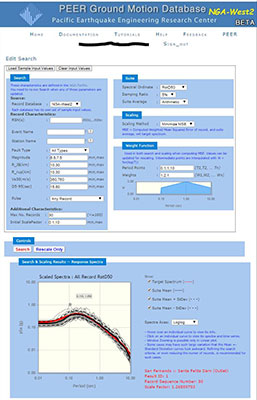PEER Ground Motion Database
New NGA-West 2 Ground Motion Database
 The old NGA-West online PEER ground motion database tool has been taken off line. The users of the PEER ground motion database should use the latest and expanded NGA-West 2 ground motion database at:
The old NGA-West online PEER ground motion database tool has been taken off line. The users of the PEER ground motion database should use the latest and expanded NGA-West 2 ground motion database at:
http://ngawest2.berkeley.edu
The new NGA-West 2 database is larger than the old database by a factor of six, and also new features have been added to the new online tool.
The Pacific Earthquake Engineering Research Center (PEER) ground motion database includes a very large set of ground motions recorded worldwide of shallow crustal earthquakes in active tectonic regimes. The database has one of the most comprehensive sets of metadata, including different distance measures, various site characterizations, and earthquake source data.
Since its release, the PEER Ground Motion database has proved to be very popular among engineers in the earthquake-related disciplines, who are increasingly using it for selection and modification of records to analyze computer models of buildings, bridges, and other facilities. The database is now cited as a primary source of ground motion records in the latest revision of the Building Seismic Safety Councilís NEHRP Recommended Provisions.
Previous PEER Ground Motion Databases
For many years, PEER has spent considerable effort in collecting and organizing ground motion databases to assure data processing consistency and accurate metadata retrieval. Previous versions were released in 2005, 2000, and 2010. These old database versions are not accessible.
Why Did PEER Develop the Database?
Modern approaches to assessing seismic performance of infrastructure rely on good information about likely ground shaking at a site. Historically, access to earthquake ground motion data has been hampered by difficult access to the large body of data, as well as by the inconsistency in how the data are gathered and stored.
In the late 1990s PEER recognized the need to improve access to earthquake ground motion data and thus embarked on an effort to create a web-based searchable database of strong ground motion data. The first step was to collect the most important ground motion records worldwide. The second step was to ensure that all the data had been processed consistently and reliably. The following step was to gather related metadata such as earthquake magnitude, various site-to-source distance measures, style of faulting, local site conditions at the recording stations, and other relevant engineering parameters. Finally, PEER created the online database to make all the information available to the public. Various enhancements to the database have been made in recent years, and the latest version of the database can be found at the top of this web page.

